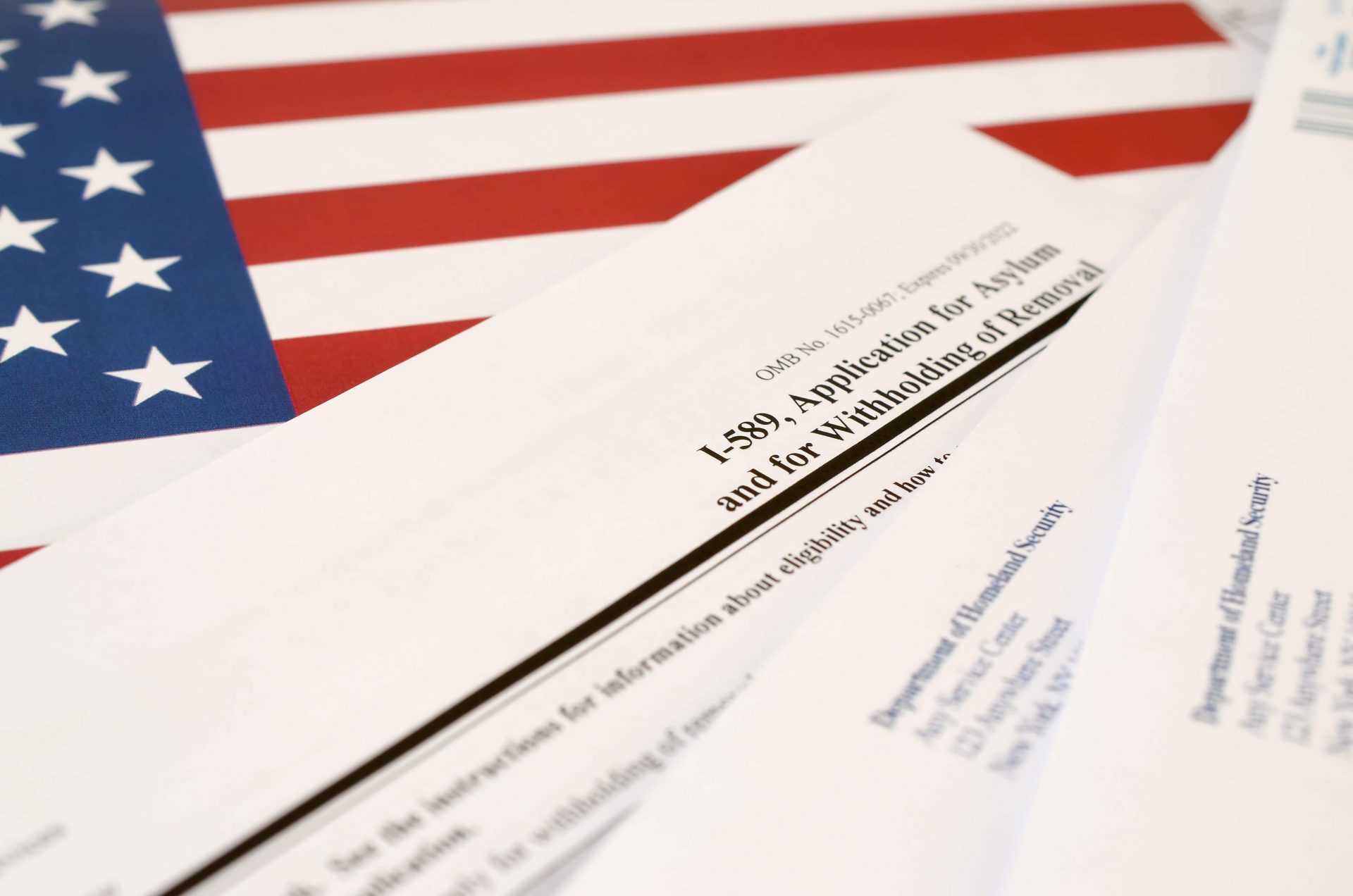

If you are fleeing persecution in your home country and seeking safety in the United States, filing Form I-589, Application for Asylum and for Withholding of Removal, is an important step toward protection.
We will cover the basics of I-589, from eligibility and cost to filing steps and processing time.
Plus, we will explain how the experienced and compassionate immigration attorneys at Spar & Bernstein can guide you every step of the way.
What Is Form I-589?
Form I-589 is used by individuals who are in the United States and want to apply for asylum and protection from removal (deportation).
Filing this form allows applicants to:
- Request asylum if they have suffered or fear they will face persecution due to their race, nationality, religion, political opinion, or membership in a particular social group, if they return to their home country
- Request withholding of removal, if they fear their life or freedom will be threatened upon return to their home country
Who Can File Form I-589?
To be eligible to file Form I-589, you must meet the following requirements:
- Be physically present in the U.S.
- Have suffered or fear future persecution due to the factors listed above
- Feel threatened by persecution or torture in your home country
Form I-589 must be filed within one year of the applicant’s arrival in the U.S.
If you do not submit Form I-589 within one year of arriving in the U.S., you may become ineligible to apply for asylum.
There are very few exceptions to filing I-589 outside the one-year window, such as:
- An important change in your country’s condition that affects your right to seek asylum
- Serious illness or disability
Talk to our experienced immigration lawyers at Spar & Bernstein to understand your options.
Form I-589: Step-By-Step Process
Here is a detailed guide about the I-589 process to ensure you don’t miss anything important.
1. Find & Review Form I-589
Go to the All Forms section of the U.S. Citizenship and Immigration Services (USCIS) website. Use the filter option to find and download I-589.
Carefully read the form’s instructions to ensure compliance with filing requirements.
2. Complete Form I-589
Provide personal information, such as your name, address, date of birth, and country of origin.
Complete all sections of the form, including:
- Part A: Biographical information about you and any dependents (spouse, children) included in the application
- Part B: Reasons for your asylum or withholding of removal request
- Part C: Your detailed statement of past persecution or fear of future persecution including events, dates, and details that support your asylum claim
Ensure your answers are detailed and consistent with any supporting documents you provide.
3. Gather Supporting Documentation
Prepare personal identification documents, such as a passport, birth certificate, or other identity documents.
Provide evidence of persecution to support your claim — these can include:
- Police reports
- Witness affidavits
- Media articles or reports about persecution in your country
- Medical records (if applicable)
- Documents that provide information about human rights in your country
All documents must be translated in English and accompanied by a certification of accuracy.
4. File Form I-589
Print the completed form (if filled out electronically), review it, then sign it. Failure to sign the I-589 may lead to denial of your application.
You can file Form I-589 with USCIS if:
- You are in the U.S. at the moment of filing
- You are not a U.S. citizen
- You have never been assigned an A-Number
- You have an A-Number but are not in immigration court proceedings
- You are in removal proceedings and are now, or were in the past, identified as an “unaccompanied alien child” (UAC)
Use the Filing Instructions Tool to check if you can file Form I-589 online or by mail.
You must file I-589 with the immigration court or Board of Immigration Appeals:
- If you’re in immigration court proceedings
- If you have never been determined as a UAC
5. Attend A Biometrics Appointment
Once you submit Form I-589, USCIS will send you a receipt notice known as Form I-797C, Notice of Action confirming that your application has been received.
After that, they will schedule a biometrics appointment to capture your fingerprints, photo, and signature for background checks.
6. Prepare & Attend Your Asylum Interview
If you filed with USCIS and are not in removal proceedings, you will be scheduled for an asylum interview at a local asylum office.
Prepare for the interview by reviewing your application and supporting documents then gathering any updated evidence.
If you are in removal proceedings, you will go to an immigration court hearing where an immigration judge will decide your case. To ensure your interests are protected and secure your peace of mind, work with an attorney who will represent you in the process.
7. Receive A Decision
After your interview or hearing, you will receive a decision on your application.
If approved, you will be granted asylum, allowing you to stay in the U.S. and eventually apply for a Green Card.
If denied, you may face removal proceedings.

Form I-589: Cost
There is no filing fee for Form I-589, making it accessible for those seeking asylum or withholding of removal.
However, there might be other costs related to the application process, such as fees for translating supporting documents and for legal representation.
Form I-589: Processing Time
The processing time for Form I-589 can vary based on your location, the caseload at the USCIS Asylum Office, and whether you have been placed in removal proceedings.
If you are following USCIS affirmative asylum process (i.e. are not in removal proceedings), the processing time can range from several months to over a year before receiving an interview and decision.
If you are following the defensive asylum process (i.e. your case is referred to the immigration court as part of removal proceedings), processing times can be longer, often taking years due to the backlog in immigration courts.

Need Help With Form I-589? Contact Spar & Bernstein
With extensive experience spanning 60+ years and thousands of immigration success stories, The Law Offices of Spar & Bernstein assist with a wide range of USCIS immigration forms, including Form I-589.
We provide comprehensive guidance throughout the entire application process, ensuring your Form I-589 is accurately completed and supported with the necessary evidence to strengthen your case.
Our knowledgeable and compassionate attorneys listen to your story and prepare you for interviews and hearings to make the most of your case.
In addition to Form I-589, we offer legal support with completion and filing of other immigration forms, such as Form I-131, Green Card applications, and work authorization requests.
If you’ve missed the one-year filing deadline for asylum, we can assess whether you qualify for exceptions based on changed or extraordinary circumstances.
Contact our experienced team and we will provide personalized legal services to protect your rights and help you navigate the complex U.S. immigration system.
Form I-589: FAQs
If you still have concerns or questions about Form I-589, take a look at the answers to some frequently asked questions.
Can I include family members in my asylum application?
Yes, you can include your spouse and children under 21 in your Form I-589 if they are in the U.S. at the time of filing.
Can I file I-589 if I missed the one-year filing deadline?
In certain circumstances you may still be eligible to file I-589 if you missed the one-year deadline. However, you will need to provide evidence of changed or extraordinary circumstances that prevented you from filing on time. Contact our immigration attorneys at Spar & Bernstein for legal advice.
Can I work in the U.S. while my Form I-589 is pending?
You can apply for an Employment Authorization Document (EAD) if your Form I-589 has been pending for at least 150 days without a decision, provided you meet certain conditions. Schedule a consultation with our lawyers at Spar & Bernstein and we’ll help you file for work authorization.
Can I file Form I-589 from outside the U.S.?
No, you can only file Form I-589 if you are physically present in the U.S.
What is the difference between asylum and withholding of removal on Form I-589?
Asylum provides broader protection and can serve as a path to permanent residence (Green Card). Withholding of removal only prevents deportation to a home country but does not offer the same long-term benefits, such as applying for a Green Card.
Can I bring my family to the U.S. if they are outside the U.S. when I file for asylum?
If you are granted asylum, you can apply to bring your spouse and unmarried children under 21 to the U.S. by filing Form I-730, Refugee/Asylee Relative Petition within two years of receiving asylum.





